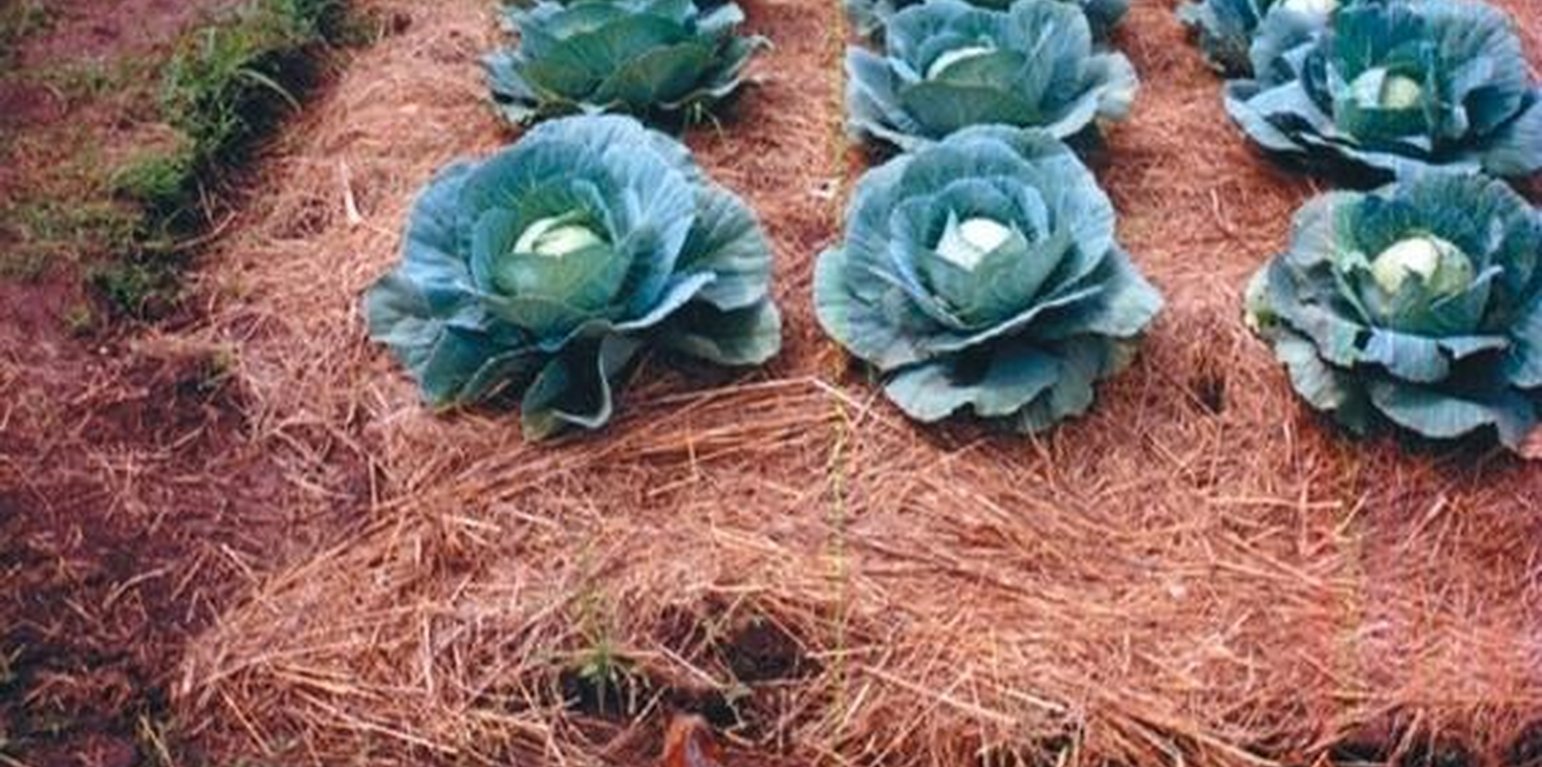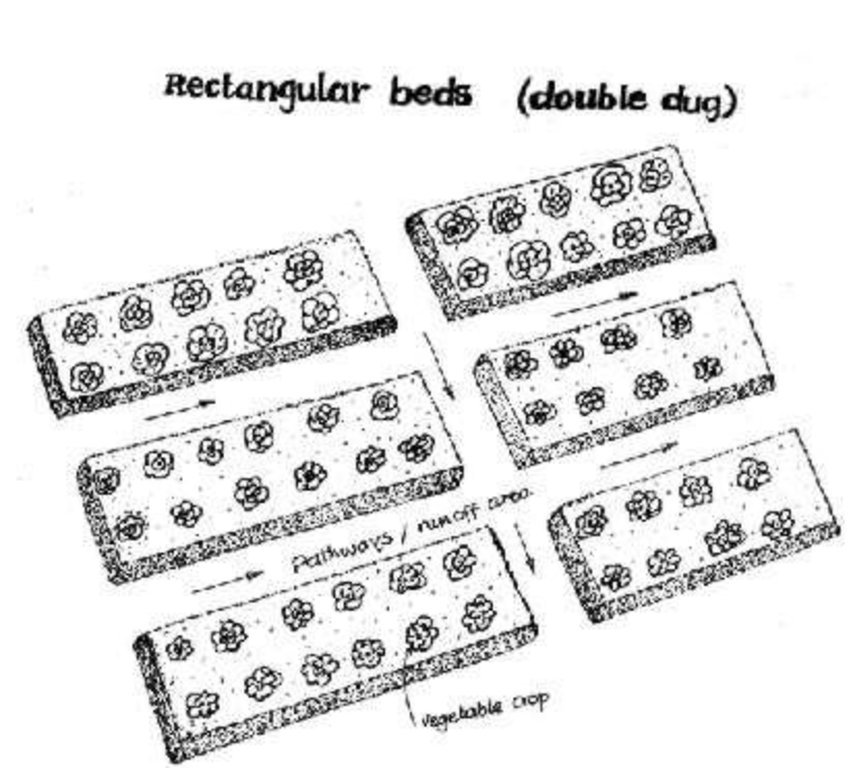double dug beds - Busia experience
(Kenya)
Description
Digging of planting beds to increase soil depth for higher moisture retention in the rootzone.
Description: Excavating the planting bed to remove the infertile sub-soil and separate the top soil. The top soi is later mixed with farm yard manure and returned into the excauated are to form the planting bed. Purpose: Improvement of water retention and root zone storage through increased depth of soil. Helps to increase the yields of crops. Maintenance: Involves repairing the shoulders of the raised beds and addition of organic manures to improve fertility. Environment: Suitable for vegetable gardens around the dweling areas but can be adopted for field crops with high value. Areas with rock outcrops and shallow underlying rocks are not suitable due to limited depth.
Location
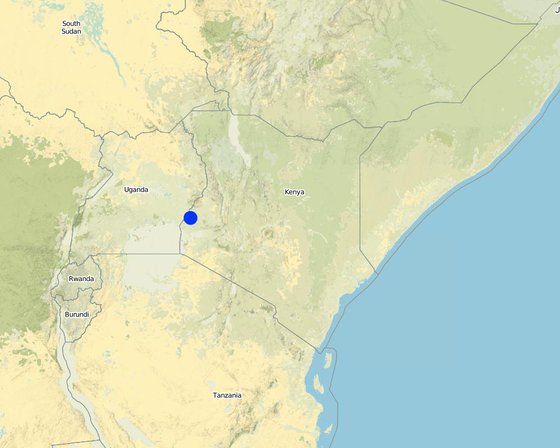
Location: Western/ Busia, Kenya
No. of Technology sites analysed:
Geo-reference of selected sites
Spread of the Technology: evenly spread over an area (1.5 km²)
In a permanently protected area?:
Date of implementation: less than 10 years ago (recently)
Type of introduction
-
through land users' innovation
-
as part of a traditional system (> 50 years)
-
during experiments/ research
-
through projects/ external interventions
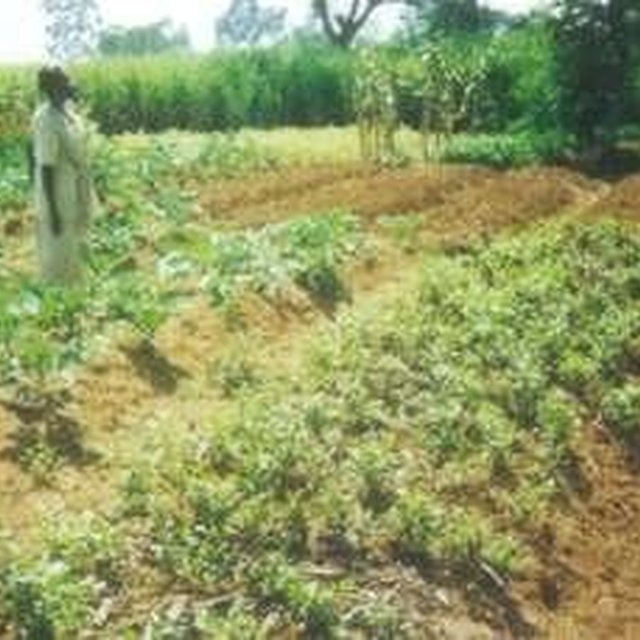
Double dug beds with vegetable crop (O.J. Bittar)
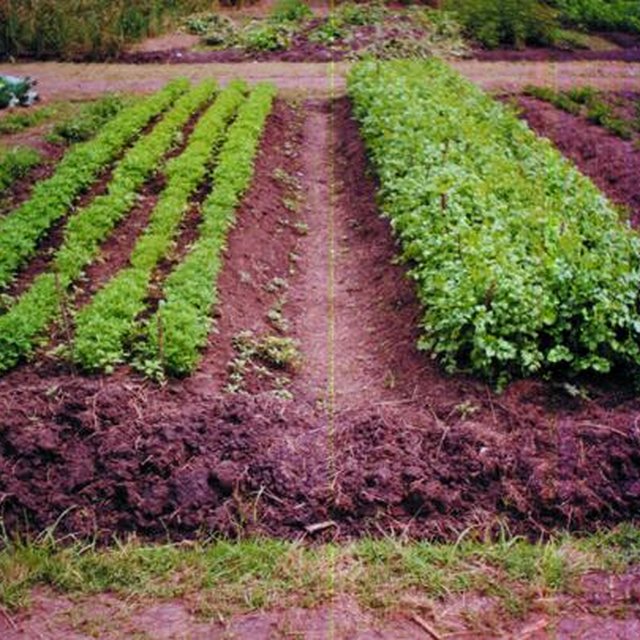
-
Classification of the Technology
Main purpose
-
improve production
-
reduce, prevent, restore land degradation
-
conserve ecosystem
-
protect a watershed/ downstream areas – in combination with other Technologies
-
preserve/ improve biodiversity
-
reduce risk of disasters
-
adapt to climate change/ extremes and its impacts
-
mitigate climate change and its impacts
-
create beneficial economic impact
-
create beneficial social impact
Land use
-
Cropland
- Annual cropping: cereals - maize, cereals - sorghum, fibre crops - cotton, root/tuber crops - cassava
- Perennial (non-woody) cropping: sugar cane
Number of growing seasons per year: 2
Water supply
-
rainfed
-
mixed rainfed-irrigated
-
full irrigation
Purpose related to land degradation
-
prevent land degradation
-
reduce land degradation
-
restore/ rehabilitate severely degraded land
-
adapt to land degradation
-
not applicable
Degradation addressed
-
chemical soil deterioration - Cn: fertility decline and reduced organic matter content (not caused by erosion)
-
water degradation - Ha: aridification
SLM group
-
improved ground/ vegetation cover
-
minimal soil disturbance
SLM measures
-
agronomic measures - A2: Organic matter/ soil fertility
Technical drawing
Technical specifications
Technical knowledge required for field staff / advisors: low
Technical knowledge required for land users: low
Main technical functions: increase in organic matter, increase of infiltration, increase / maintain water stored in soil, improvement of soil structure
Secondary technical functions: control of concentrated runoff: retain / trap
Deep tillage / double digging
Remarks: The bed width need to be narrowto allow ease of operations by attendant
Establishment and maintenance: activities, inputs and costs
Calculation of inputs and costs
- Costs are calculated:
- Currency used for cost calculation: Kenya shilling
- Exchange rate (to USD): 1 USD = 65.0 Kenya shilling
- Average wage cost of hired labour per day: 0.80
Most important factors affecting the costs
Labour is the most important and is abudant, at a cost of KES 50 or U$ 0.8 per man day. Opportunities of group work can be employed to reduce total cost of technology establishment.
Establishment activities
-
layout of seedbeds (Timing/ frequency: None)
-
Excavation to remove the top soil (Timing/ frequency: Dry season)
-
Excavation to remove the subsoil (Timing/ frequency: Dry season)
-
mixing top soil with manure (Timing/ frequency: Dry season)
-
returning the mixture to the excavated bed (Timing/ frequency: Dry season)
Maintenance activities
-
.Layout of planting beds (Timing/ frequency: Dry season / Whenever necessary)
-
Excavation to remove top soil (Timing/ frequency: Dry season /)
-
Excavation to remove subsoil (Timing/ frequency: Dry season / once for all)
-
Mixing top soil with manure (Timing/ frequency: Dry season / As necessary)
-
returning the mixture to the excavated bed (Timing/ frequency: Dry season / once for all)
-
repairing raised edges of tillage beds (Timing/ frequency: dry season/every season)
-
digging in manure (Timing/ frequency: dry season/on demand)
-
mulch application (Timing/ frequency: all year/during cropping)
Natural environment
Average annual rainfall
-
< 250 mm
-
251-500 mm
-
501-750 mm
-
751-1,000 mm
-
1,001-1,500 mm
-
1,501-2,000 mm
-
2,001-3,000 mm
-
3,001-4,000 mm
-
> 4,000 mm
Agro-climatic zone
-
humid
-
sub-humid
-
semi-arid
-
arid
Specifications on climate
Annual rainfall: Also 1,501-2,000 mm
Slope
-
flat (0-2%)
-
gentle (3-5%)
-
moderate (6-10%)
-
rolling (11-15%)
-
hilly (16-30%)
-
steep (31-60%)
-
very steep (>60%)
Landforms
-
plateau/plains
-
ridges
-
mountain slopes
-
hill slopes
-
footslopes
-
valley floors
Altitude
-
0-100 m a.s.l.
-
101-500 m a.s.l.
-
501-1,000 m a.s.l.
-
1,001-1,500 m a.s.l.
-
1,501-2,000 m a.s.l.
-
2,001-2,500 m a.s.l.
-
2,501-3,000 m a.s.l.
-
3,001-4,000 m a.s.l.
-
> 4,000 m a.s.l.
Technology is applied in
-
convex situations
-
concave situations
-
not relevant
Soil depth
-
very shallow (0-20 cm)
-
shallow (21-50 cm)
-
moderately deep (51-80 cm)
-
deep (81-120 cm)
-
very deep (> 120 cm)
Soil texture (topsoil)
-
coarse/ light (sandy)
-
medium (loamy, silty)
-
fine/ heavy (clay)
Soil texture (> 20 cm below surface)
-
coarse/ light (sandy)
-
medium (loamy, silty)
-
fine/ heavy (clay)
Topsoil organic matter content
-
high (>3%)
-
medium (1-3%)
-
low (<1%)
Groundwater table
-
on surface
-
< 5 m
-
5-50 m
-
> 50 m
Availability of surface water
-
excess
-
good
-
medium
-
poor/ none
Water quality (untreated)
-
good drinking water
-
poor drinking water (treatment required)
-
for agricultural use only (irrigation)
-
unusable
Is salinity a problem?
Occurrence of flooding
Characteristics of land users applying the Technology
Market orientation
-
subsistence (self-supply)
-
mixed (subsistence/ commercial)
-
commercial/ market
Off-farm income
-
less than 10% of all income
-
10-50% of all income
-
> 50% of all income
Relative level of wealth
-
very poor
-
poor
-
average
-
rich
-
very rich
Level of mechanization
-
manual work
-
animal traction
-
mechanized/ motorized
Sedentary or nomadic
-
Sedentary
-
Semi-nomadic
-
Nomadic
Individuals or groups
-
individual/ household
-
groups/ community
-
cooperative
-
employee (company, government)
Age
-
children
-
youth
-
middle-aged
-
elderly
Area used per household
-
< 0.5 ha
-
0.5-1 ha
-
1-2 ha
-
2-5 ha
-
5-15 ha
-
15-50 ha
-
50-100 ha
-
100-500 ha
-
500-1,000 ha
-
1,000-10,000 ha
-
> 10,000 ha
Scale
-
small-scale
-
medium-scale
-
large-scale
Land ownership
-
state
-
company
-
communal/ village
-
group
-
individual, not titled
-
individual, titled
Land use rights
-
open access (unorganized)
-
communal (organized)
-
leased
-
individual
Water use rights
-
open access (unorganized)
-
communal (organized)
-
leased
-
individual
Access to services and infrastructure
Impacts
Ecological impacts
surface runoff
Quantity before SLM: 15
Quantity after SLM: 5
Cost-benefit analysis
Benefits compared with establishment costs
Short-term returns
very negative
very positive
Long-term returns
very negative
very positive
Benefits compared with maintenance costs
Short-term returns
very negative
very positive
Long-term returns
very negative
very positive
Adoption and adaptation
Percentage of land users in the area who have adopted the Technology
-
single cases/ experimental
-
1-10%
-
11-50%
-
> 50%
Of all those who have adopted the Technology, how many have done so without receiving material incentives?
-
0-10%
-
11-50%
-
51-90%
-
91-100%
Number of households and/ or area covered
190 households
Has the Technology been modified recently to adapt to changing conditions?
To which changing conditions?
-
climatic change/ extremes
-
changing markets
-
labour availability (e.g. due to migration)
Conclusions and lessons learnt
Strengths: land user's view
Strengths: compiler’s or other key resource person’s view
Weaknesses/ disadvantages/ risks: land user's viewhow to overcome
Weaknesses/ disadvantages/ risks: compiler’s or other key resource person’s viewhow to overcome
References
Reviewer
-
David Streiff
-
Alexandra Gavilano
Date of documentation: Junie 5, 2011
Last update: Mei 8, 2019
Full description in the WOCAT database
Documentation was faciliated by
Key references
-
Water Conservation and harvesting - A minor Field Study.. 2001.: SWCB, MOARD Nairobi, Kenya
